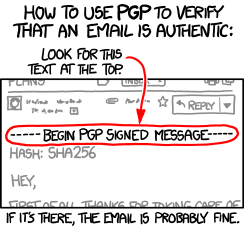Cryptography and Email
A decade or so ago it was fairly rare for cryptography and email technology to intersect – there was S/MIME (which I’ve seen described as having “more implementations than users”) and PGP, which was mostly known for adding inscrutable blocks of text to mail and for some interesting political fallout, but not much else.
That’s changing, though. Authentication and privacy have been the focus of much of the development around email for the past few years, and cryptography, specifically public-key cryptography, is the tool of choice.
DKIM uses public-key cryptography to let the author (or their ESP, or anyone else) attach their identity to the message in a way that’s almost impossible to forge. That lets the recipient make informed decisions about whether to deliver the email or not.
DKIM relies on DNS to distribute it’s public keys, so if you can interfere with DNS, you can compromise DKIM. More than that, if you can compromise DNS you can break many security processes – interfering with DNS is an early part of many attacks. DNSSEC (Domain Name System Security Extensions) lets you be more confident that the results you get back from a DNS query are valid. It’s all based on public-key cryptography. It’s taken a long time to deploy, but is gaining steam.
TLS has escaped from the web, and is used in several places in email. For end users it protects their email (and their passwords) as they send mail via their smarthost or fetch it from their IMAP server. More recently, though, it’s begun to be used “opportunistically” to protect mail as it travels between servers – more than half of the mail gmail sees is protected in transit. Again, public-key cryptography. Perhaps you don’t care about the privacy of the mail you’re sending, but the recipient ISP may. Google already give better search ranking for web pages served over TLS – I wouldn’t be surprised if they started to give preferential treatment to email delivered via TLS.
The IETF is beginning to discuss end-to-end encryption of mail, to protect mail against interception and traffic analysis. I’m not sure exactly where it’s going to end up, but I’m sure the end product will be cobbled together using, yes, public-key cryptography. There are existing approaches that work, such as S/MIME and PGP, but they’re fairly user-hostile. Attempts to package them in a more user-friendly manner have mostly failed so far, sometimes spectacularly. (Hushmail sacrificed end-to-end security for user convenience, while Lavabit had similar problems and poor legal advice).
Not directly email-related, but after the flurry of ESP client account breaches a lot of people got very interested in two-factor authentication for their users. TOTP (Time-Based One-Time Passwords) – as implemented by SecureID and Google Authenticator, amongst many others – is the most commonly used method. It’s based on public-key cryptography. (And it’s reasonably easy to integrate into services you offer).
Lots of the other internet infrastructure you’re relying on (BGP, syn cookies, VPNs, IPsec, https, anything where the manual mentions “certificate” or “key” …) rely on cryptography to work reliably. Knowing a little about how cryptography works can help you understand all of this infrastructure and avoid problems with it. If you’re already a cryptography ninja none of this will be a surprise – but if you’re not, I’m going to try and explain some of the concepts tomorrow.
